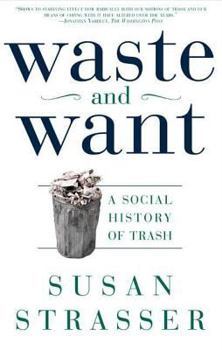Waste and Want: A Social History of Trash
Select Format
Select Condition 
Book Overview
An unprecedented look at that most commonplace act of everyday life-throwing things out-and how it has transformed American society. Susan Strasser's pathbreaking histories of housework and the rise... This description may be from another edition of this product.
Format:Paperback
Language:English
ISBN:0805065121
ISBN13:9780805065121
Release Date:September 2000
Publisher:St. Martins Press-3PL
Length:368 Pages
Weight:1.25 lbs.
Dimensions:1.0" x 5.9" x 8.9"
Related Subjects
Americas Biological Sciences Ecology Economic Conditions Economics Engineering Environment Environmental Economics Historical Study & Educational Resources Political Economy Political Science Politics & Government Politics & Social Sciences Science Science & Math Science & Scientists Science & Technology Social History Social Science Social SciencesCustomer Reviews
3 ratings
Quite interesting
Published by Thriftbooks.com User , 15 years ago
I read this book for research because I wanted to know what people used to do with trash (or what we now call trash). If you're interested in the answer, this is a good book to read. It discusses in detail what people used to do in the 1800's (and before) with old clothing, food scraps, cooking fats, worn or broken items, etc., and how and why that changed over time up until the present.
Wonderfully instructive Real eye opener
Published by Thriftbooks.com User , 17 years ago
What an intriguing book. Not at all what I expected since I had assumed that materialism and toss out rather than repair was something that became the norm after WW2. The book says this actually happened close to one hundred years earlier. Interesting that during the Great Depression advertisers told people that buying, even on credit would be good. That changed when WW2 happened and sugar, gas etc were rationed, and people were once again encouraged to grow a vegetable garden, mend items rather than toss out. Reading of the mid 1800's how women saved all clothing however well worn, and either repaired or torn apart to make into braided rugs etc reminded me of my paternal grandmother whom I can still see sitting in a comfortable chair making what once was shirts, dresses, skirts into large braided rugs for various rooms in our house. Also enjoyed reading how even in New York city in the early 1900's had people who kept pigs in their back yards or basements. How no food scrap went to waste, because food wastes were either fed to the animals or put into a compost pile which would become rich fertile soil. The information the author shares concerning flour sacks was really interesting, because I had long known that women would save, wash flour, seed, food sacks and make them into wearable clothing. But I had no idea that these sacks had washable dyes so that the women could wash them and have a pretty printed sack clothe, to make items. I also didn't know that women would take worn sheets, cut them down the middle and then sew both good sides together to get double duty out of the bed sheet. Living in a cottage here in the Mother Lode of California where the California gold rush began, I am well aware that people didn't have garbage dumps where they could take empty bottles etc. So as you dig in the back yards around here you encounter scads of blue, clear, amber colored bottles that must have held medicines or other home items in the 1800's. Writing on page 112 the author shares how 'cities passed antidumping ordinances throughout the nineteenth century, but many people ignored them'. And that 'Periodic epidemics renewed the pressure on lawmakers to pass new regulations, to establish boards of health, or make special appropriations for cleaning up particularly bad messes'. Reminds me of anti-littering laws we have and the dreaded EPA toxic waste sites. Seems little has changed in some ways. One page 120 the author writes 'Urban America discovered the 'garbage problem' in the late 1880's and early 1890's writes historian Martin Melosi; addressing it was the second step in the sanitary reformers' campaign, after clean water and good sewers.' Something to think about when one studies the various illnesses that were around when open sewers, contaminated well water etc were a constant concern. Wish more people would stop and think about what a blessing the modern sewer plant is, in preventing major illnesses, often life threatening of
A Treasure based on Trash
Published by Thriftbooks.com User , 24 years ago
Exceptionally fine read! Discusses with fascinating clarity what, on the surface, would appear to be a repellant subject. American History has a whole new meaning. This book answers the unspoken questions of "what DID they do with...." in an orderly, systematic yet very interesting way. Who would have known garbage could be so riveting?Well written, without technical jargon and extremely well organized. Strausser has turned a sow's ear into a silk purse. Excellent discussion of the why and how of our detritus disposal through the ages right up through the Hippie revival of the 70's and the Recycling Exchange on the internet today.I can highly recommend this book to anyone with even a slight interest in the cycle and re-cycle of our castoffs. The integral involvement of the homemaker in early days was a genuine eye-opener and a sparkling promise of future possibilities for us all.




